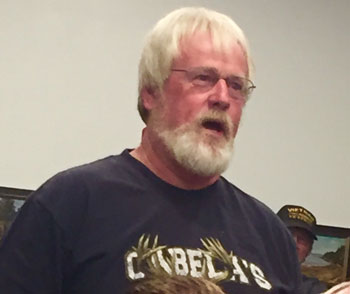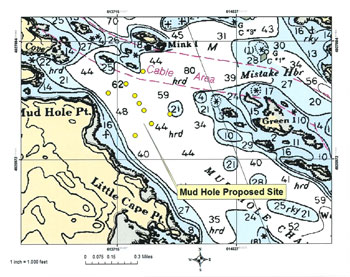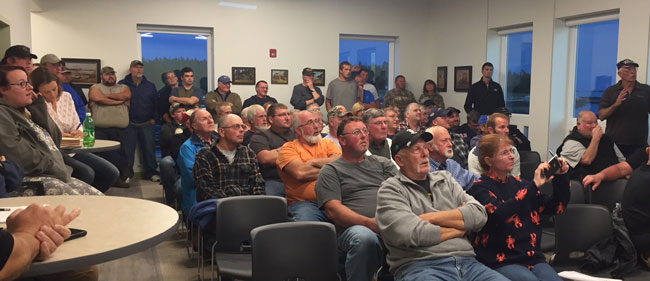Jonesport/Beals Fishermen Opposed Proposed Salmon Pen Complex
by Nancy Beal

Raymond Alley exhorted the lobstermen to “come out in numbers” in hopes of discouraging Cooke from proceeding to a formal application. Nancy Beal photo.
The Canadian aquaculture giant Cooke Aquaculture USA, already the holder of three licenses for salmon pens in Eastern Bay between Beals Island and Jonesport’s Head Harbor Island, is poised to seek a fourth site: 44.4 acres in the middle of Mud Hole channel between Mink Island and Beals’ Mud Hole Point, the southern bound of a long, v-shaped cove known as the Mud Hole.
The Mud Hole is where the Down East Institute for Marine Research (DEI), a recently completed $6 million complex in Beals’ Black Duck Cove district, has been experimentally protecting soft shell clams, a decades-old Maine fishery decimated in recent years by green crabs. Located on the southern side of the cove is the northeastern extension of a trail system created by The Nature Conservancy as part of its 1,500-acre Great Wass Preserve. On the northern side is prime waterfront property offered for sale by a local family company.
Cooke had scheduled a “scoping session” on the proposed pens for October 1 but, when word of the proposal spread like wildfire throughout the Moosabec area, the fishermen organized their own gathering five days in advance.
Raymond “Raymie” Alley, a Beals lobsterman who has fished in Eastern Bay all his life, took charge of the meeting. Noting that Cooke already held licenses for three other salmon fixtures in that bay, he said that the complexes of circular floats supporting nets and anchored by heavy, unmarked moorings, imposed “continual expense” on area fishermen.
“We lose the bottom and gear,” he said. “If you get wound up in the moorings, you’ve lost your trap. Anything you make [on lobsters] you lose in gear.” Some fishermen had even experienced damage to their boats from entanglements with such moorings, he said. Even when the pens are retired, the ocean floor beneath them is “ruined” for 15 to 20 years, he said, adding that he felt pollution of the ocean bottom was the “strongest point” local fishermen could make against the pens.
Alley reported on a lengthy telephone conversation he had had with Department of Marine Resources scientist John Lewis, one in the line of license reviewers that ends at the commissioner. Answering questions about the monitoring of salmon pen sites for compliance with DMR regulations pertaining to water quality and ocean bottom, Alley said Lewis told him that, prior to the issuance of a license, the DMR “puts divers down to test for flushing purposes.” Over a decade ago, however, the monitoring of licensed sites was handed over to the Department of Environmental Protection, which has no divers on staff. Monitoring, according to Lewis, is now carried out by divers hired by Cooke who report their findings to the DMR.
We lose the bottom
and gear.
– Raymond Alley,
lobsterman, Beals
There were plenty of comments from the approximately three dozen men and women sitting on the bleachers in the Beals Elementary School gym. Jonesport fisherman Rocky Alley, who is president of the Maine Lobstermen’s Union, offered to bring to the October 1 meeting the lawyer whom he said the AMLU had used to battle offshore windmills, dumping dredged material in Portland waters, and other issues.
Beals lobsterman Sonny Beal, warned, “Just because you don’t fish there doesn’t mean it doesn’t affect you.” The fishermen who are driven out of the pen area will go somewhere else, he said, putting pressure on lobstermen who had already staked out their territory in those areas. He urged his colleagues to document their presence in the pen area with photographs and chart plotter data. As the local representative to the Maine Lobstermen’s Association, he promised to take the cause to the MLA to garner support.
Ramie Alley exhorted the lobstermen to “come out in numbers” to the October 1 scoping session in hopes of discouraging Cooke from proceeding to a formal application.
The Cooke plan
Nearly 100 fishermen, fishing industry advocates, selectmen and the area’s legislative representative were present when Cooke officials brought their slides and commentary to the 50-seat DEI conference room October 1. The seats were full and many stood around the back of the room, or on the patio outside. Before the evening was over, several would complain about the inadequacy of the hall.
Michael Szemerda, Cooke’s vice president for saltwater operations, conducted the meeting on behalf of the international giant which has operations in Canada, the United States (Maine and Washington State), Chile and Scotland. According to the company website and a company spokesperson, Cooke extended its vertically integrated salmon farming operation into Maine waters over 20 years ago when is bought out financially troubled salmon farming companies Atlantic Salmon of Maine, Heritage Salmon and Stolt Sea Farm. Their Maine operations, which Szemerda said yield 2.5 million fish each year, are located in Cobscook Bay, Machiasport (where they also maintain a processing plant), Beals/Jonesport and Black Island between Mount Desert and Frenchboro.
The proposed Mud Hole complex, which would command twice the area as the one introduced at Calf Island in Jonesport waters four years ago, would resemble the 20-pen group at Black Island, Szemerda said, putting up a slide of the group in Frenchboro waters. Following the company’s three-year rotation practice, fish would be introduced and allowed to grow for two years, after which they would be harvested and the pens allowed to lie fallow for about eight months before the process would start again.
The opposition

Yellow dots off Mud Hole Point, upper left, indicate some of the proposed fish pen locations in the 44.4 acre lease site.
Szemerde had barely finished his presentation when one of the lobstermen who stood to lose fishing ground if the new pens were licensed and installed yelled, “Is there anyone in this room that wants this?” The answer was an immediate loud chorus of “No!” Another wanted to know how many acres of ocean Cooke had exclusive rights to in Maine. The answer was between 600 and 700. If the Mud Hole site were approved, 100 of those acres would come out of Eastern Bay, said the fisherman, adding three smaller, much older sites and the Calf Island group. “You keep taking a junk, and the pie’s going to run out,” commented a third.
Others reported finding dead lobsters in the traps they set near the pens, fostering the claim that fish farming spoiled the water for other species. Another man, who is also a diver and had been hired during the 1990s to clean the ocean floor under the pens, reported that the bottom was black and the dead fish were white and exploded in his hands when he picked them up.
Towns or individuals could
request to be placed on a
list to be notified of any
license application.
– Marcy Nelson, Maine DMR
Others claimed that salmon farming contributed to debris in the ocean. As long as the site was full of fish and making money, alleged Raymie Alley, the pens were well kept and well attended. When they are lying fallow, he said, only the nets are removed, leaving the pens to break up, drift and go ashore. Another in the audience reported finding feeding tubes well offshore, and others snarled that there were “lines all over the bay.”
Szemerda said many of the practices of the 1990s were no longer used today. Parrying questions about the effect that chemicals used to control lice had on water quality, he noted that Cooke was transitioning to “green technology” to remove sea lice. The new method puts the fish through a warm water bath that causes lice to drop off before the fish are returned to the salt water. This method was already in use in Machiasport, he said, and a machine to implement it elsewhere was under construction.
Monitoring is now
carried out by divers
hired by Cooke who
report their findings
to the DMR.
“If the pens in calm water are falling apart, what’s it going to be on that shore?” asked Alley in reference to the granite slabs that make up the shoreline where the new pens would be located. In a storm, said a colleague, there’s a tremendous sea surge. “Hurricane? We’re out of there!” he said of what lobstermen do with their traps when a bad blow is forecast.
One Beals fisherman, recalling that Eastern Bay fishermen had once been asked to move their traps to allow a large boat to reach the pens, asked how Cook’s large boats would navigate a bay plastered with trap buoys. While the site was chosen for its deep, fast-moving water, Eastern Bay is peppered with small islands and ledges and the proposed pen area’s western perimeter is near the edge of the channel where the depth rises abruptly to 16 feet. The question was never answered.
Tax revenue, scallops, notification
In his opening remarks, Szemerda had stated that Cooke Aquaculture USA employed 270 people in Maine in “permanent, good-paying jobs.” MLU President Alley asked how many new jobs the Mud Hole complex would create. Szemerda’s reply was “approximately eight,” a mix of managers and laborer. Alley asked further how many from the Jonesport-Beals area were currently employed. Szemerda said he didn’t know of any.

Jonesport fisherman Rock Alley, front row, center, who is president of the Maine Lobstermen’s Union, offered to bring to the October 1 meeting the lawyer whom he said the AMLU had used to battle offshore windmills, dumping dredged material in Portland waters, and other issues. Nancy Beal photo.
Alley next wanted to know the value of the proposed pens ($12.5 million was the answer) and how much revenue the town of Beals would net from them. Szemerda’s associate said the company pays the town of Beals $8,000 in property taxes. (Beals town records indicate that Cooke paid about $7,400 last year: $5,236 for the pens, valued at $22,000 each, and another $2,164 for land and buildings.) Alley’s reaction was swift: Considering how much profit Cooke makes and what little the towns get in return, he said, “Why should we want you to come down here and [expect us] to turn over [our fishing grounds] to you?”
There were a few lobstermen present who drag scallops in the wintertime, and they pointed out that the proposed pen area was rich in scallops as well as in lobsters. One said that there had been at least 20 scallopers working the area the last time the scallop management’s three-year rotation plan opened the area.
Szemerda said (a)
new method puts the
fish through a warm
water bath that causes
lice to drop off.
Another, who said he had served on the state’s scallop Advisory Council for several years, commented that Cooke should “shorten up the scope” of its proposed plan. Still a third winter scallop harvester reminded the crowd that the presence of healthy scallop beds had helped to ward off the installation of salmon pens near The Brothers, an island group north of Eastern Harbor.
Others, including Beals’ first selectman Daniel Davis, were concerned that proposals such as Cooke’s slipped through without the locals knowing they were in progress. (Only two people had turned up for the DMR’s official hearing on Cooke’s Calf Island application in Jonesport.) Marcy Nelson of the DMR explained that her department was only obligated to notify the town whose waters were involved, which is why Beals was not alerted to the Calf Island site, even though its citizens were affected by the DMR’s granting of the license. She added that towns or individuals could request to be placed on a list to be notified of any license application, which would apprise them of any applications made to the DMR statewide.
As Szemerda closed the session, Rocky Alley asked for a show of hands of those who favored the pens. No hand went up. Raymie Alley got the last word, suggesting what others had already said in other ways: “No new site, and take the existing ones out!”
